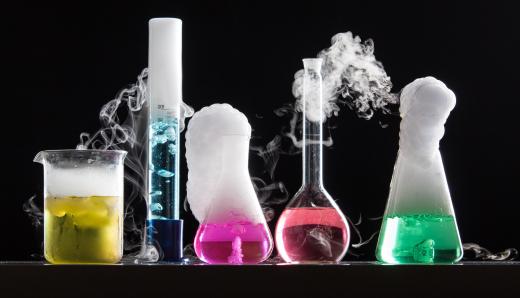What Is Aqueous Sodium?
Aqueous sodium is the liquid form of sodium dissolved in a solvent such as water. Some common aqueous reactions involve sodium hydroxide, chloride and silver nitrate. In general, aqueous solutions can react with water in three types of reactions: precipitation reactions, acid-base reactions and oxidation-reduction reactions.
Aqueous solutions are identified in chemical reaction equations with a subscripted (aq). The solid form of elemental sodium is represented as Na<(s)>, while aqueous sodium is denoted as Na(aq). A simple mixture of sodium and water creates aqueous sodium. The amount of sodium dissolved in water can be increased or decreased to achieve a desired concentration. Different concentrations are needed to drive different chemical reactions.

Sodium is an alkali metal that belongs to a group of elements known as electrolytes. Electrolytes bear free ions that carry a slight electrical charge that allows them to easily bind with hydrogen molecules, especially those found in water. Aqueous sodium is an example of an electrolyte solution. Other electrolytes or ions that dissolve in aqueous sodium are chloride (Cl-), calcium (Ca2+), potassium (K2+), magnesium (Mg2+, hydrogen phosphate (HPO42-) and hydrogen carbonate (HCO3-).
A common example of an aqueous sodium chemistry reaction is the combination of aqueous silver nitrate and sodium chloride. When the aqueous forms of silver nitrate and sodium chloride are combined, the reaction produces a solid precipitate made of silver and chloride. If aqueous sodium hydroxide and hydrochloric acid are combined, the acid-base reaction produces electrically charged aqueous sodium chloride. An oxidation-reduction reaction occurs between solid sodium and gaseous chloride to produce table salt.
There are several other aqueous reactions involving sodium. Sodium iodide and sodium nitrate can react to form a white precipitate. Sodium sulfate and lead nitrate produce a white precipitate, as well. These and the many other aqueous chemical solutions have applications in chemical engineering, molecular biology and physics.
As for sodium itself, the element got its chemical symbol from the Latin name for sodium carbonate, natrium. Sodium is the sixth most abundant element on Earth; however, it is never found occurring freely in nature. Sodium is a very reactive alkali metal that can ignite on contact with moisture.
The pure form of sodium was isolated in 1807 by English chemist Sir Humphry Davy, who used an early electrolysis method. Since then, sodium has been incorporated into many aspects of daily life. Sodium is used to produce titanium, coolant for nuclear reactors, and bright yellow lights for street lamps.
AS FEATURED ON:
AS FEATURED ON:











Discuss this Article
Post your comments